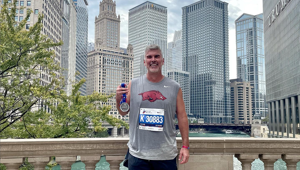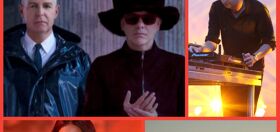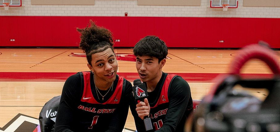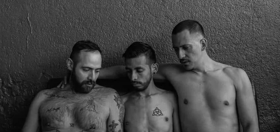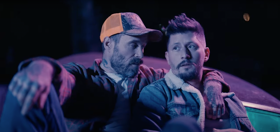
Tim Wolfer likes to describe himself in one word: humanitarian.
The journalist and documentary director has spent a career tracking humanitarian crises around the globe. His debut feature Adopting Haiti followed the work of a group of American aid workers fighting to bring 135 children from a Haitian orphanage to the United States. He followed up with several journalistic shorts on refugee crises in Sudan, Bangladesh and Cuba, before lighting on his most recent endeavor: The Right Girls.
The Right Girls follows a group of transgender women, primarily the effervescent, El Salvador-born Valentina, as they join the notorious migrant caravan from South America to the United States in 2018. Seeking a life free of violence and abuse, she, along with her friend Chantal and Joanne set off on the 2,200-mile journey on foot. Wolfer followed them the entire way, as the group hitched rides, camped outdoors and endured hunger & abuse along the way. The film offers an eye-opening and humanizing look at the ongoing migrant crisis in the Americas, and calls Americans to action over the destructive policies of the Trump Administration.
The Right Girls just landed on streaming services this week. We spoke with Wolfer about the film and his own harrowing journey across Mexico.
How about we take this to the next level?
Our newsletter is like a refreshing cocktail (or mocktail) of LGBTQ+ entertainment and pop culture, served up with a side of eye-candy.
How does a movie like this even begin to come about?
I’ve been covering stories of migration for the past 10-12 years, whether in Central Africa or Asia. The one thing migrants always have in common is that they are always looking for better opportunities. So when Trump started tweeting out about how these people coming from Mexico were all criminals, were all thieves, saying all these horrible things, I knew that wasn’t the truth. So I decided to go down and figure out what the real story was.
Sure.
So I flew to southern Mexico, found the caravan, and within the first couple hours of meeting up with them I met these women. I was just super compelled to the community they had formed. They were keeping each other safe and splitting resources. So I asked if I could follow them, and they said sure. And I just kept, day after day, following them. What was supposed to be a three or four-day trip ended up being about six weeks.

How did filming go day-to-day? Did you leave the girls and meet up with them?
At night I would find hotels, at least initially in Southern Mexico. I would find hotels and split rides with other journalists. Then, as we inched up, sometimes I would stay nearby and go meet up with them. Once in a while, I would lose them for a day or two, but I’d always meet up with them again. And we’d just keep going.
Did you fear for your safety? You’re trekking through areas controlled by gangs and drug cartels.
There were times when I found myself in a situation where I’d feel like we needed to keep moving. But you do your best and follow best practices. That’s why I was teaming with other journalists along the way. And you also realize you have a mission and a job to do. So I stuck with it. You forget about the fear if you focus on what you’re doing.
We should add at this point that the caravan consisted of thousands of people. Were the other migrants questioning you, how or why you were making the film?
No. There were so many other journalists—hundreds of journalists. You remember the caravan…
Oh, of course.
It was packed with foreign journalists. So it wasn’t weird to have me around.

This is a harrowing, harrowing film. What surprised you the most in your journey?
You know what surprised me the most? They made it. That’s the honest truth. When I was on the caravan I was always comparing it to a marathon. It’s like all these people get to the finish line and there’s no tarp, no Gatorade and nobody to greet them. It’s a horrible, horrible situation. That’s what it was for a vast majority of them. That anyone from the group made it to the border is astonishing. It blows my mind.
So what was the day-to-day atmosphere like within the caravan? Were people excited? Were they scared?
I think it was fairly inspiring. You have all these people with a common mission, and they came up with this idea to caravan and protect each other. As they got closer and closer to Tijuana, it just got more and more depressing. I would also say that for the transgender community, they are part of the caravan, but you can see in this film that they’re getting discrimination from people within the caravan.

Oh sure.
So it was a delicate situation they were in.
The constant harassment is very tough to watch. But, it’s inspiring to see queer-oriented charities there to aid LGBTQ migrants. That’s particularly encouraging when you take into account they’re offering safety to trans women.
The two big ones in that space are Refugee and Immigrant Center for Education and Legal Services (RAICES) and the Santa Fe Dreamers Project. They’re the ones that spearheaded to help figure out logistics.
What was the hardest thing to see?
It would have to be the constant harassment these women were under. You get to know them. They’re my friends now; we text all the time. That was hard to watch as it waned on. And it became so consistent—they were always the last ones in the camp, always the last ones to get food.

When you get to the border, was it a feeling of elation? Of hope?
You know, it came in phases. When they got to Tijuana, I think they all thought it would be a couple days before they’d cross. Then it was a couple more days. Then it was a couple more. Then they had to move cities. When I finally did watch two of the girls go across the border, it was kind of a feeling of shock and awe, and wondering what would happen next. I’m sure you’ve heard the horror stories about the detention centers, and for the trans community in those detention centers.
Oh goodness, yes.
I just worried about them until Valentina texted me.
What is the state of their lives at this point?
They’re all doing well. I think COVID has taken a toll on their economic opportunities. But they’re living here in the US.
So do you intend to stay in journalism, or do you want to do more filmmaking?
My career path from here would be to look [subjects for] films that are a cross between migration and journalism, but always focus on the human story. I like to take facts and figures and humanize them. I think that’s something we really accomplished. I hope this film gives these women agency for their own story. People knew about the caravan, and people are opening up to LGBTQ issues in a new way. So I want to continue to humanize that and humanize migrants who have been very demonized.

So much of your work revolves around migration. What is it about the phenomenon that fascinates you so?
I think about it like this: What is it that would allow us to drop everything in our lives and do what they did? I can’t imagine hitting that point. But it is happening more and more. So there’s a curiosity and fascination, but the people who do follow through with it are some of the strongest people I’ve ever seen. It’s a strange thing.
What is the commonality you’ve witnessed among migrants, having researched them all over the world?
A lot of the time they’re usually younger. That’s just the age you can move and uproot yourself. Almost always, there are economic problems, whether personally or from a failed state. In this case, it’s also identity. [Trans women migrants] don’t feel welcome in their own country or surroundings, so they have to move on. The migrants from Myanmar have lived there for generations, but they were no longer welcome there, so they had to flee. I don’t think that’s abnormal. The horrible part is that we then demonize them, whomever they may be. They are people looking for better futures.
Specifically, to that point, I certainly have met people who demonize migrants as if they ate babies or something.
Yeah.
I haven’t quite been able to wrap my head around that. What’s wrong with wanting a better life? Isn’t that the point of the United States? Has that not always been the reason people immigrate here? People want to be happy. They want to be safe. The vitriol immigrants face is really upsetting. I don’t understand the anger. What’s your experience been?
It’s been the same. Rarely is the rhetoric against migrants—the anger, as you say—true. But you look through history and that’s kind of the way it always is. These are stories that need to be told and people should really understand the issues. And it’s going to be happening more and more. Climate change is the next big coming. It’s going to be a bigger and bigger issue.
So what’s the solution?
Good policy. Build people up so we don’t have to deal with crises. We traditionally have had good policy. Refugees are allowed to request asylum in the United States. These women did that legally. But the way [the Trump Administration] has been blocking that is putting caps on the number of people who can request asylum. So we need to have a better policy and elect people that will have a better policy.
The Right Girls is available on Amazon, iTunes & YouTube.
This article includes links that may result in a small affiliate share for purchased products, which helps support independent LGBTQ+ media.




